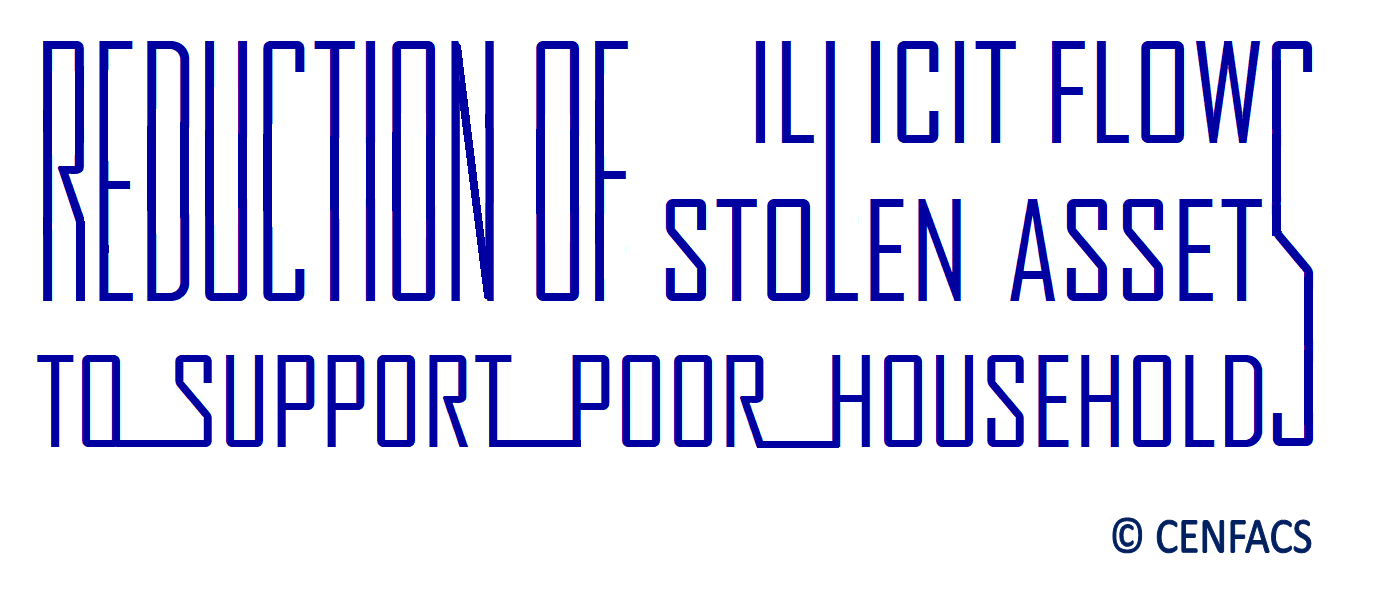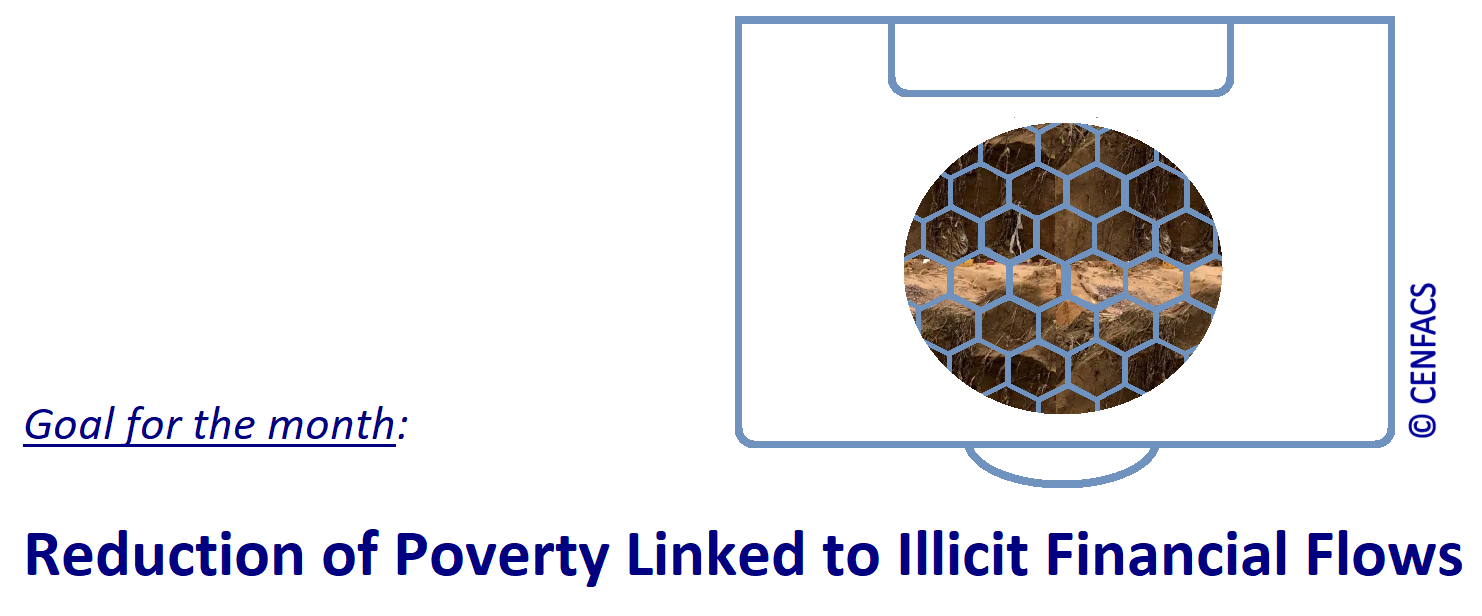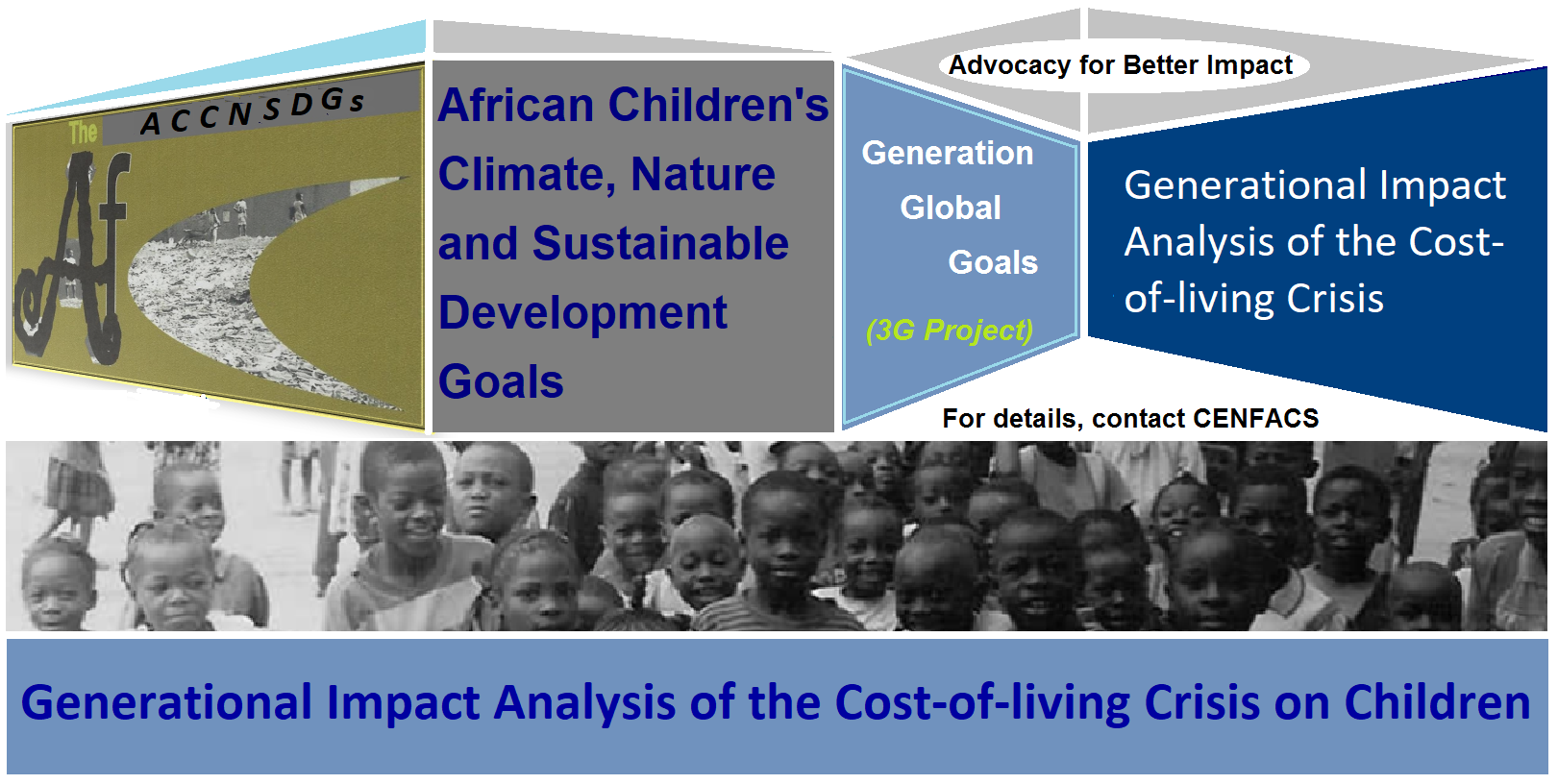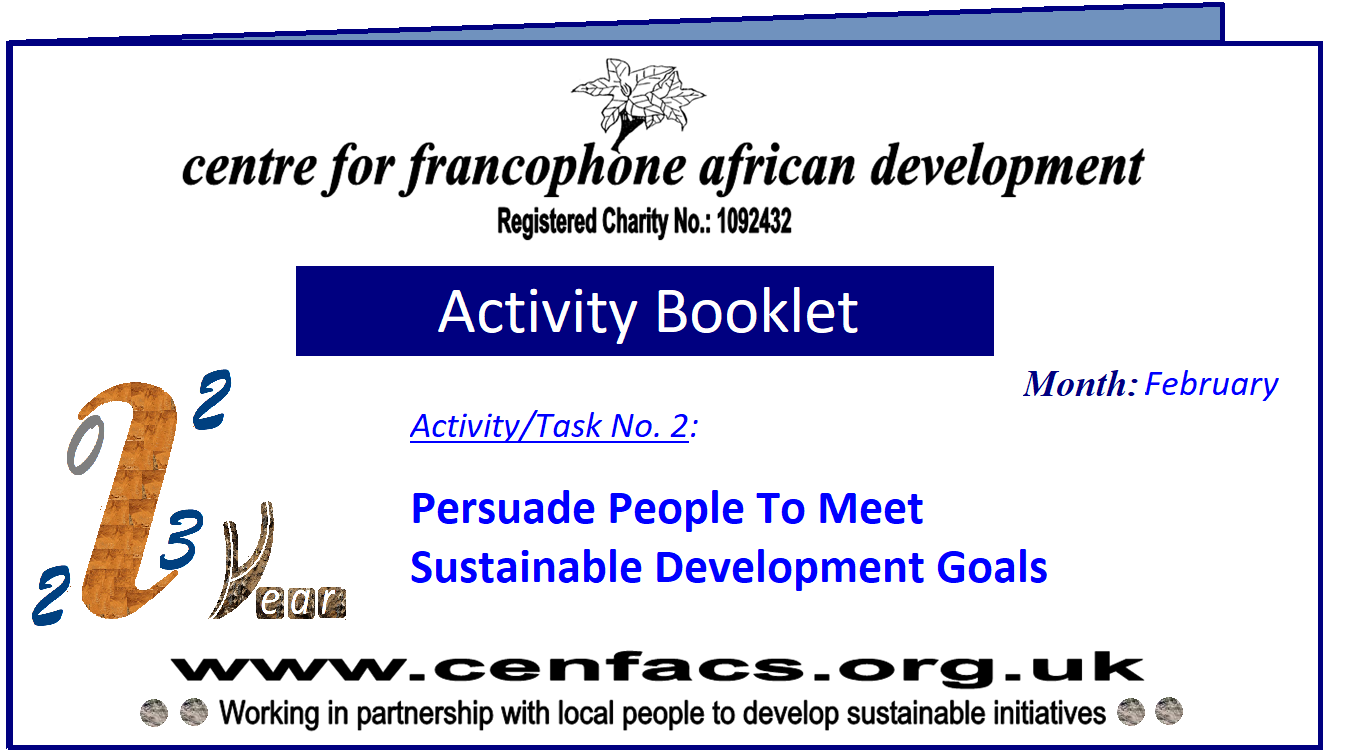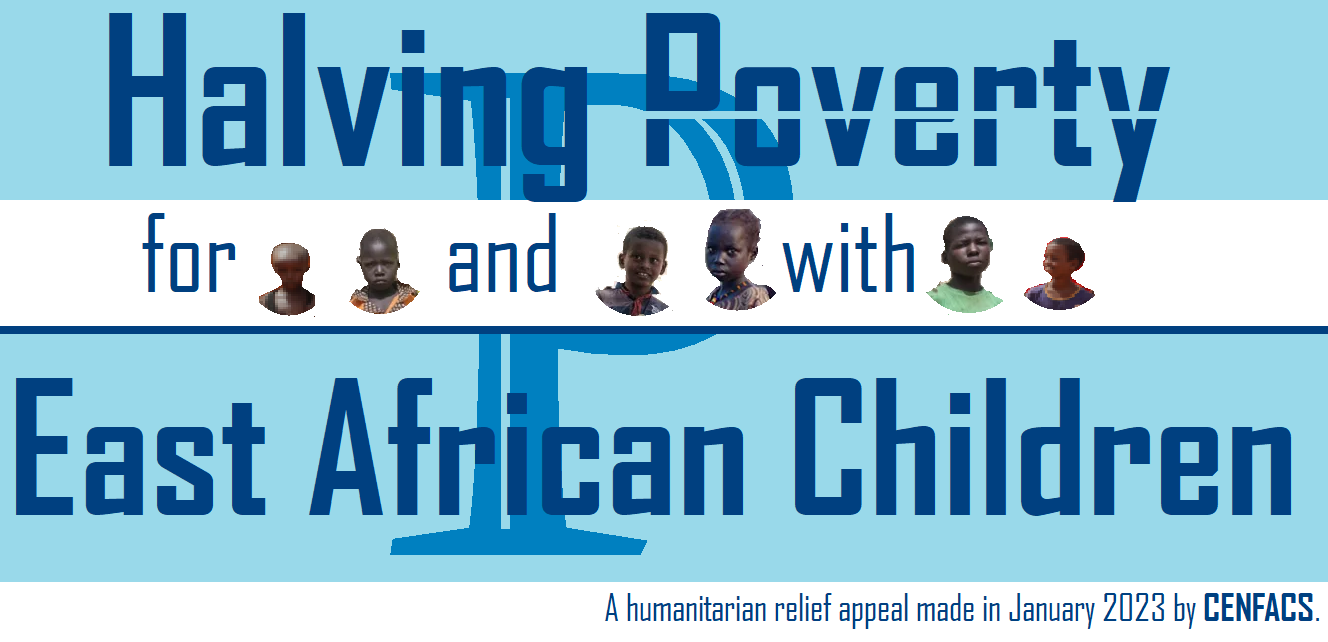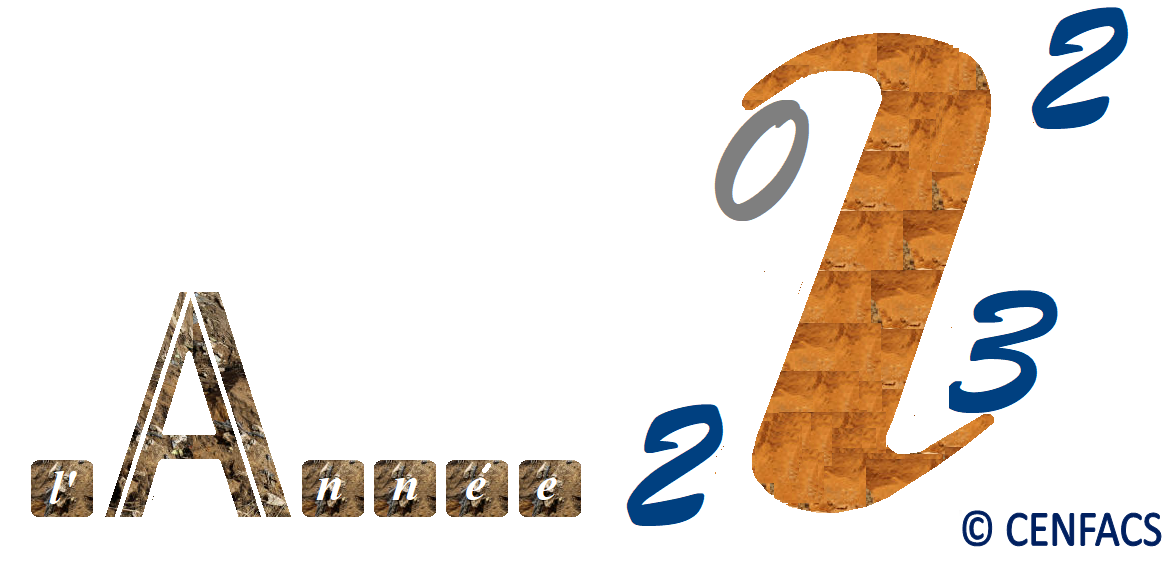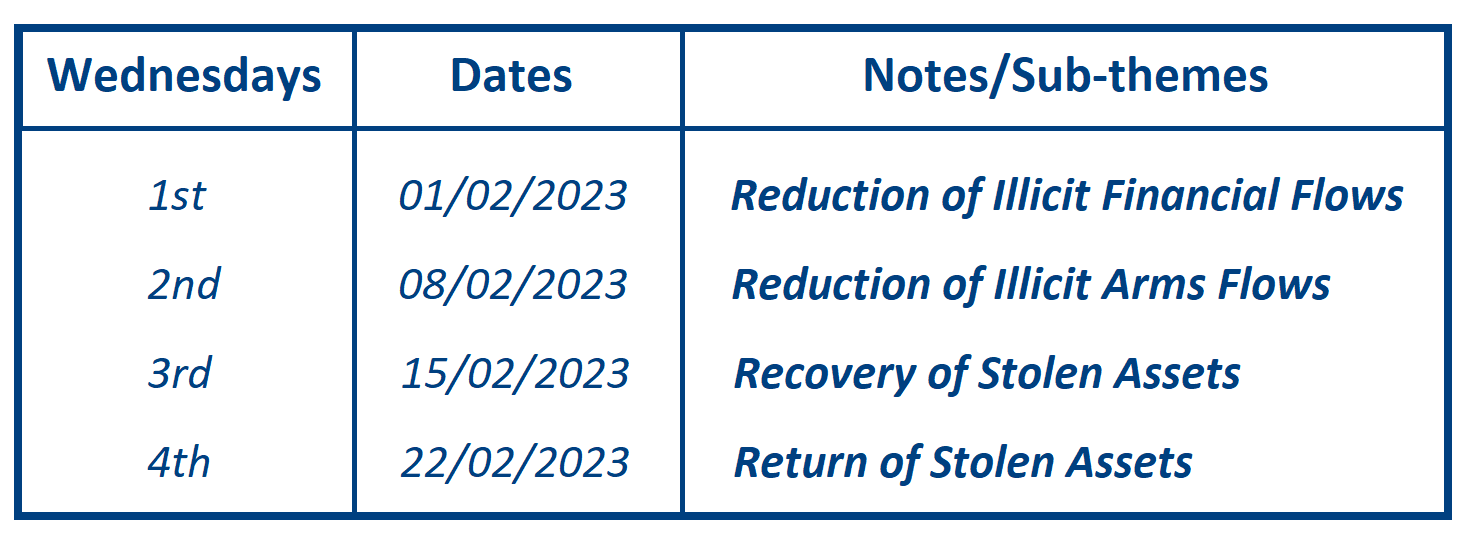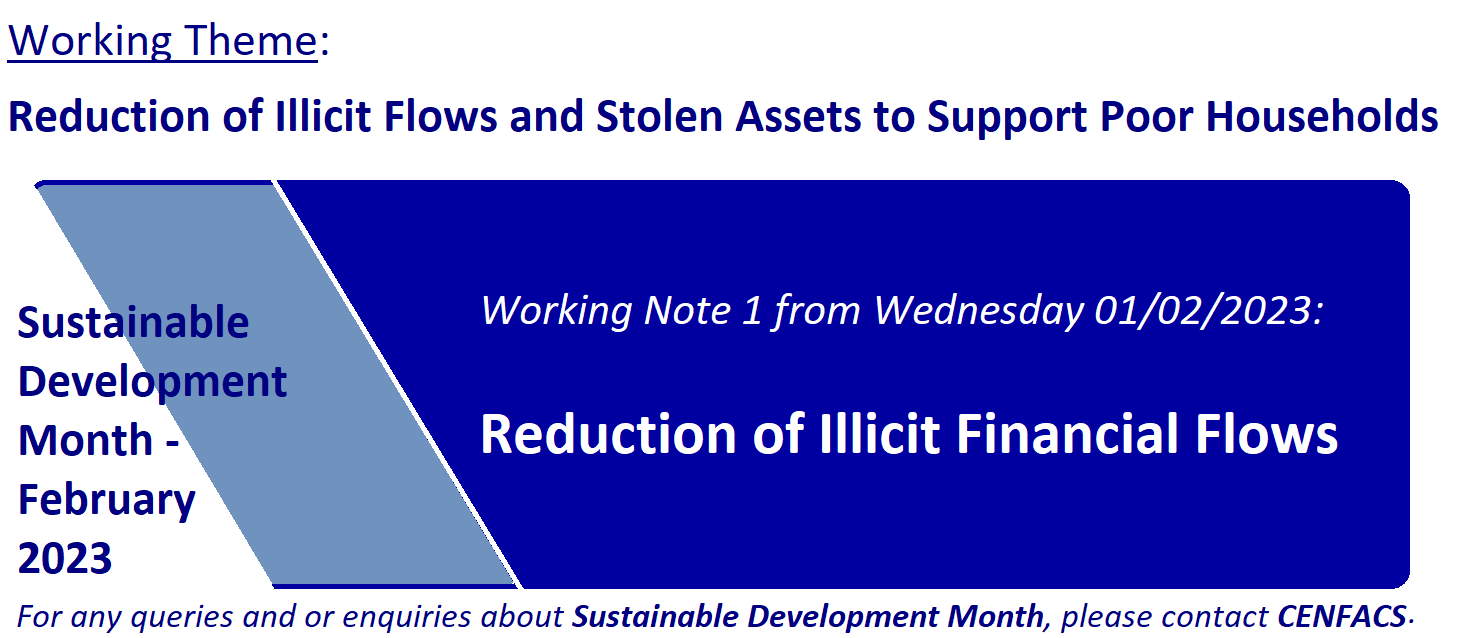Welcome to CENFACS’ Online Diary!
01 February 2023
Post No. 285
The Week’s Contents
• Sustainable Development Month with the Reduction of Illicit Flows and Stolen Assets to Support Poor Households
• Goal for the Month: Reduction of Poverty Linked to Illicit Financial Flows
• African Children’s Climate, Nature and Sustainable Development Goals (Generation Global Goals Project): Generational Impact Analysis of the Cost-of-living Crisis on Children
… And much more!
Key Messages
• Sustainable Development Month with the Reduction of Illicit Flows and Stolen Assets to Support Poor Households
February is the month of Sustainable Development, according to CENFACS development calendar or planner. It is the month during which we revisit our works relating to sustainable development. In particular, we try to look at again the United Nations (1) Seventeen Sustainable Development Goals (SDGs) and their related 169 targets. We normally select one of the topics within the set of SGDs and targets; and try to work on it. For this February 2023, we have selected Goal 16 and Target 4 of this goal.
• • Goal 16 and Target 4 as Working Theme for the Month of Sustainability
Goal 16 is to promote peaceful and inclusive societies for sustainable development, provide access to justice for all and build effective, accountable and inclusive institutions at all levels.
Target 4 of Goal 16 is to significantly reduce illicit financial and arms flows, strengthen the recovery and return of stolen assets and combat all forms of organized crime, by 2030.
Although Goal 16 speaks about societies and institutions, human societies and institutions are made of humans. Humans (people) can form households. Thus, Goal 16 and Target 4 are about people and households.
Within the Target 4 of Goal 16, we have chosen to deal with the reduction of illicit financial and arms flows, and the recovery and return of stolen assets.
To make our Month of Sustainability, we are going to engage our community members through the chosen aspects of the Target 4 while keeping the spirit of Goal 16 as it was set up by the United Nations. Additionally, we are looking at how the same selected aspects can be related to poor people, particularly poor households that make up CENFACS‘ noble cause of poverty reduction.
• • Engaging our Members in Supporting the Reduction of Illicit Financial and Arms flows, and the Recovery and Return of Stolen Assets
We are indeed engaging the members of our community to be supportive of the messages contained in the Goal 16 and Target 4. We are also advocating for a proportion of the proceeds from the reduction of illicit financial and arms flows as well as from the recovery and return of stolen assets to be allocated to reduce poverty, to support poor households.
Our advocacy can be explained as follows. During the coronavirus pandemic and even now at this time of the cost-of-living crisis, there have been some searches for funding to meet the costs of the coronavirus disaster and the cost-of-living crisis. Although some funding has been secured through varied sources like grants, donations and loans; there are other sources of funding that are untapped. Amongst these untapped sources are illicit financial flows and the monetary value of stolen assets.
Yet, these untapped or dormant funds could have been found and made available to contribute to the efforts of meeting the lingering effects of the coronavirus disaster and the crippling effects of the cost-of-living crisis. These illicit financial flows and stolen assets could be tracked, recovered and returned where they belong to or where they were taken.
Eventually, those in charge of the process of dealing with these illicit flows and stolen assets can negotiate with their owners (public or private) and explore the possibility of releasing a portion of the recovered funds and assets to fund poverty and deserving causes. They could be used to support poor people and poor households.
For instance, as part of building a sustainable recovery in Africa, it is understandable for Africa to ask for the tracking, the recovery and return of illicit financial flows and stolen assets. There have been some positive responses to Africa’s demand for the return of stolen assets, although much needs to be done.
It equally makes sense for CENFACS to advocate for part of the dividend from the reduction of illicit financial and arms flows and the recovery and return of stolen assets to be used to support poor households. This can be done under clearly defined terms and conditions.
To enable us to approach the theme of the reduction of illicit financial and arms flows and the recovery and return of stolen assets, we have organised a plan of work which can be found under the Main Development section of this post. Under the same section, we have provided more details about the same theme.
• Goal for the Month: Reduction of Poverty Linked to Illicit Financial Flows
Our goal for February 2023 is to reduce any forms of poverty linked to illicit financial flows. To achieve this goal, one may need to understand the meaning of illicit financial flows.
• • Understanding Illicit Financial Flows
There are many definitions of illicit financial flows within the international finance literature; definitions which tend to be similar. For instance, the World Bank (2) argues that
“Illicit Financial Flow refers to cross-border movement of capital associated with illegal activity or more explicitly, money that is illegally earned, transferred or used that crosses borders”.
Illicit financial flows can create or exacerbate poverty and hardships for the people in need. Particularly, during this challenging time of the cost-of-living crisis, they can make the matter worse for those who need this capital or money the most.
To explain how illicit financial flows can make matter worse, Janvier Désiré Nkurunziza (3) contends that
“Illicit financial flows increase risk and uncertainty in the domestic economy, discouraging investment and its potential positive effect on poverty reduction. Moreover, in countries where corruption allows the elites to unlawfully appropriate resources and transfer them abroad, the incentive to put in
place economic and social measures that reduce poverty is weakened. Illicit financial flows allow the elites to easily access foreign services such as
healthcare and education, leaving the poor to fend for themselves”.
Nkurunziza’s argument can be influential in terms of implications for those who would like to see the reduction of illicit financial flows in order to support those living in poverty such as poor households.
• • Implications for selecting the goal for the month
After selecting the goal for the month, we focus our work and mind set on the selected goal by making sure that in our real life we apply it. We also expect our supporters to work on the same goal by supporting those who may be suffering from the type of poverty linked to the goal for the month we are talking about during the given month (e.g., February 2023).
For further details on the goal of the month and its selection procedure including its support, please contact CENFACS.
• African Children’s Climate, Nature and Sustainable Development Goals (Generation Global Goals Project): Generational Impact Analysis of the Cost-of-living Crisis on Children
Normally, the project that carries this month of Sustainable Development is African Children’s Climate and Sustainable Development Goals (ACSDGs). It is also known as Generation Global Goals (3G) project.
3G project is the impact level in CENFACS’ process of advocating that global goals (like the United Nations Sustainable Development Goals) work for children and not way around. It is indeed the testing of the gains that global goals claim to achieve and of their impact on the welfare and well-being of children. This is regardless whether these children are in spaces and times of peace or lack of peace (like conditions of wars, areas stricken by viruses or epidemics and time of natural disasters). Unsurprisingly, these gains should be materialised even in time of health crisis like the coronavirus pandemic or any other crisis such as the cost-of-living crisis.
Since December 2022, we inserted in the 3G project the Kunming-Montreal Global Biodiversity Framework (4). Although we included nature goals stemming from this framework, we are not measuring their impact. The reason is these nature goals were only agreed in December 2022. It is too early to measure their impact on children. But, what do mean by ‘generational impact analysis’?
• • Children generation of global goals
The children generation of global goals are those two generations of children relating to two sets of global goals: Millennium Development Goals (MDGs) and Sustainable Development Goals (SDGs). The generation of Millennium Development Goals will be those children or persons born and live between 2000 and 2015, whereas the generation of Sustainable Development Goals will be referred to those born and live from 2015 until now (ideally between 2015 and 2030). The two generations are relating to the lifespan of these two sets of goals.
These generations relating to global goals have to be differentiated from the conventional definition of generations which classified them as follows: Gen Alpha (2013 – 2025), iGen/Generation Z (1995 -2012), Millennials/Generation Y (1980 – 1994), Xennials (1975 – 1985), Generation X/Baby Bust (1965 – 1979) and Baby Boomers (1946 – 1964). This is without forgetting the generation who has been impacted by the scars of the coronavirus pandemic disaster.
• • Impact analysis
We are going to use the definition of impact analysis as given by the Organisation for Economic Cooperation and Development (OECD). The OECD (5) differentiates ex ante impact analysis from ex post impact assessment. According to the OECD, ex ante impact analysis is
“Part of the needs analysis and planning activity of the policy cycle. It involves doing a prospective analysis of what the impact of an intervention might be, so as to inform policymaking – the policymaker’s equivalent of business planning”.
From the above clarification of children generation of global goals and impact analysis, it is possible to speak about generational impact analysis.
• • Generational impact analysis
The generational impact analysis would be a set of tasks that we will perform to identify children generation of sustainable development goals; generation that has been impacted by a change/disruption brought the scarring effects of the cost-of-living crisis.
We are going to establish a chain of causation or theory from the cost-of-living crisis to impact as well as to measure or describe the changes induced along that chain. Briefly, we are going to refer to cause-and-effect approach and to the theory of change.
• • Early inference of the effects of the cost-of-living crisis on Poor Children
Our work on generational economics and the intergenerational transmission of poverty continues with the study/analysis of the generational impact of the cost-of-living crisis on children and future generations. We started this impact analysis three years ago by looking at how COVID-19 may have delayed the realisation of several aspects of the United Nations Climate and Sustainable Development Goals for children.
We are continuing our work by looking at how the cost-of-living crisis may have impacted different generations of children. This generational impact analysis of the cost-of-living crisis will be on children we can call as the generation of sustainable development goals (SDGs) or the generation of children thought to be the beneficiaries of the implementation of SDGs.
Although we are using the word impact, it is clear that any real impact of crisis will be known in the long term as there are still data to be collected and treated quantitatively and qualitatively. This may take sometimes.
It is possible to start inferring the effects of the cost-of-living crisis on poor children. So far, a number of agencies and individuals have tried to do it. As far as we are concerned, we are trying to seize the early outputs or effects of the cost-of-living on the realisation of SDGs linked to children’s well-being and welfare. However, one needs to be cautious in interpreting what we may have found.
• • Generational impact of the cost-of-living crisis on children generation of SDGs via a policy response trajectory curb
It is without doubt that the cost-of-living crisis is leaving and will leave some scars and fractures in the realisation of SDGs, particularly but not exclusively those aspects of these goals relating to children. Its impact can be measured by using the model of an inverted-U policy response pathway as given by the World Economic Forum (6). It is this policy response trajectory curb (that is, soaring prices, prices peaked and declining prices) that we are going to refer to to get the generational impact we are talking about.
In this study, we have not included the climate impact as this will be a matter of another advocacy which we will deal with at a different time during this year.
• • Possible effects of the cost-of-living crisis on children regarding the realisation of SDGs
The study on some of the SDGs we selected (for example Goal 1 which is about Ending poverty in all its forms everywhere) will help to speculate on how the cost-of-living is impacting or can impact the realisation of SDGs for children (particularly but not exclusively African children).
For example, a combination of current economic and financial challenges (like the rise in the cost of renting, interest rates, food prices, energy prices, etc.) can pose serious problems to children today and to future generations. These generations may find difficult to rent, to earn a decent income, to pay for their education, etc. if the ascending trends of costs and prices continue while incomes and earnings are not following suit. Likewise, the impact of an increase in income tax can have adverse effects on the generations to come. Besides that there are devastating effects of the cost-of-living crisis for children living in Africa.
For those who would like to know more about our findings from the damaging effects of the cost-of-living crisis and the stories of poverty reduction happening in Africa from CENFACS’ Africa-based Sister Organisations working with children, they should not hesitate to contact CENFACS.
To get the full extent of the possible effects of the cost-of-living crisis on children regarding the realisation of SDGs, please also contact CENFACS.
Extra Messages
• Activity/Task 2 of the ‘i‘ Project: Persuade People to Meet Sustainable Development Goals
• Triple Value Initiatives, All Year Round Projects: Extra Support about Start-up, Fundamentals and Goals
• The Polycrisis-impacted Children of East Africa Need Your Influence Right NOW
• Activity/Task 2 of the ‘i‘ Project: Persuade People to Meet Sustainable Development Goals
With the lingering effects of the cost-of-living crisis and disheartening impacts of the cost-of-living crisis, many people are struggling to meet sustainable development goals (SDGs). They may need some help and support to meet these goals. Part of this help and support could be just for someone or something to influence them.
As part of Activity/Task 2 of the ‘i‘ Project, we are asking to those who can to motivate or inspire or persuade those who are struggling to meet SDGs so they can find the power, the means and capacity to meet them. In terms of the ‘i‘ Project, we are simply asking to positively influence them to meet these SDGs.
For those members of our community who are struggling or failing to meet SDGs and who would like some help in terms of motivation or positive influence, they should not hesitate to ask for help by contacting us.
To contact CENFACS, please use the details provided on the contact-us page of this site.
• Triple Value Initiatives, All Year Round Projects: Extra Support about Start-up, Fundamentals and Goals
Last week, we announced the kick off for our Triple Value Initiatives, initially known as All Year-round Projects. For those who are interested in engaging with these initiatives, we would like to highlight the following three points: start-up, fundamentals and goals.
• • Triple-Value-Initiatives Start up
It is better to start up early, although people can always join at any time. The earlier you start the better. This is because everybody is busy with their own lives and has other things to do. Also, the earlier you start, the earlier CENFACS can help if one encounters any problems. Briefly, the message is start up early.
• • Triple-Value-Initiatives Fundamentals
You need to get the fundamentals about All Year-round Projects right from the beginning. You need to clearly sort out the basic principles and bases of these projects so that you move to the right direction early without being forced to change course as you progress or repeat from scratch. Briefly, the message is get the fundamentals right.
• • Triple-Value-Initiatives Goals
Whether you play or run or vote for poverty reduction and sustainable development, the all exercise is for you to reach your goal of delivering the objectives you set up from the onset. It means you need to be clear in your mind set about what you want to achieve. Again, if you have any problems in setting up clear goals (aim or purpose) and objectives, CENFACS can be of help. Briefly, the message is be clear about what you want to achieve.
You can select a theme to run, create your play station game and watch people to vote. This is what Triple Value Initiatives or All Year Round Projects are all about. Good luck!
• The Polycrisis-impacted Children of East Africa Need Your Influence Right NOW
You can help halve poverty in East Africa; you can help halve poverty for and with children at risk of loosing their life because of the detrimental effects of the poly-crisis on them.
You can donate your Influence to halve poverty in East Africa.
To donate, please contact influential persons (or those having the keys) to reduce or solve the detrimental effects from the crises that the East African children are suffering from and make these persons reduce or end these negative effects on them.
You can as well influence the things or factors that determine these crises in order to create lasting favourable conditions towards an end to years-long crises, like the conflicts or economic crises in Ethiopia, Somalia and South Sudan.
Please also let CENFACS know about your influencing work or contribution you are or will be making and its outcome on behalf of the children or peoples of East Africa.
To let us know, you can contact CENFACS as follows:
*over phone
*via email
*through text
*by filling the contact form on this site.
On receipt of your message or influencing donation, CENFACS will contact you for record and thank you for any influencing donation made. However, should you wish your influencing support to remain anonymous; we will respect your wish.
Thank you in anticipation for your willingness to give your Positive Influence and help save the lives of the Polycrisis-impacted East African Children, especially but not exclusively those living in the polycrisis-affected areas of Ethiopia, Somalia and South Sudan.
Message in French (Message en français)
• 2023 comme une année d’influence positive sur la réduction de la pauvreté
Pour obtenir des résultats positifs ou attendus, tout effort visant à réduire la pauvreté ne signifie pas nécessairement qu’il faut compter fortement sur les moyens financiers. Il existe d’autres moyens, tels qu’une influence positive, qui peuvent ajouter de la valeur à l’aide humanitaire, par exemple. Nous disons influence positive car nous savons tous/toutes que l’influence peut aussi être négative.
Ainsi, 2023 sera consacrée comme une Année d’influence positive sur la réduction de la pauvreté au sein du CENFACS. À partir de ce dévouement, nous espérons que les besoins de nos bénéficiaires pourront être satisfaits par l’utilisation d’une influence positive pour mobiliser le soutien et les ressources pour la satisfaction de leurs besoins.
C’est l’année où nous sommes impatients de travailler avec les membres de notre communauté et les organisations sœurs basées en Afrique en influençant les compétences, les styles et les modèles pour aider à réduire la pauvreté et à renforcer le développement durable. Influencer les compétences, les styles et les modèles aidera à aborder les crises et les situations difficiles afin d’obtenir les meilleurs résultats pour la réduction de la pauvreté.
C’est une année où l’on utilise les principes fondamentaux d’influencer les autres, en particulier ceux/celles qui sont en position de pouvoir, pour mieux changer les choses afin que la réduction de la pauvreté puisse être réalisée pour ceux/celles qui en ont besoin. La réduction de la pauvreté ne vient pas toujours d’elle-même, à moins que ceux/celles qui en détiennent la clé n’aient le sentiment qu’une influence positive leur est apportée. Mais qu’entendons-nous par influence ?
• • Comprendre l’influence
Il existe de nombreuses façons d’aborder l’influence. En ce qui concerne le dévouement de cette année à l’influence positive pour réduire la pauvreté pour les membres du CENFACS, nous nous référons à ce que le « Centre pour le leadership créatif » (7) soutient, à savoir:
“L’influence est la capacité d’influencer personnellement les actions, les décisions, les opinions ou la pensée des autres. En fin de compte, l’influence vous permet de faire avancer les choses et d’atteindre les résultats souhaités “.
Le même « Centre pour le leadership créatif » différencie trois tactiques d’influence clés ou façons d’influencer, qui sont: les appels logiques (la tête), les appels émotionnels (le cœur) et les appels coopératifs (les mains).
• • Appliquer les 3 trois tactiques d’influence clés (c’est-à-dire la tête, le cœur et les mains) pour attirer des personnalités influentes
Tout au long de 2023, nous utiliserons notre tête, notre cœur et nos mains pour faire appel à ceux/celles qui peuvent (c’est-à-dire les personnalités influentes) pour nous aider à réduire la pauvreté et à renforcer le développement durable. Il s’agira d’influencer positivement (c’est-à-dire d’inspirer et de motiver) ces personnes influentes en faisant avancer les choses et en obtenant des résultats en matière de réduction de la pauvreté.
Nous avons déjà établi un projet (le projet ‘i‘) pour mettre en œuvre cette dédicace. Le projet ‘i‘ est une initiative d’un an commençant à partir de la semaine du 23 janvier à la fin décembre 2023. Cependant, pour ceux/celles qui voudraient en savoir plus sur cette dédicace, ils/elles sont libres de se renseigner auprès du CENFACS. De même, pour ceux/celles qui voudraient le soutenir, ils/elles sont invité(e)s à le faire.
Nous espérons que vous travaillerez avec nous ou que vous serez avec nous pendant que nous tentons d’influencer les personnes influentes pour réduire la pauvreté tout au long de 2023 et au-delà.
Main Development
• Sustainable Development Month with the Reduction of Illicit Flows and Stolen Assets to Support Poor Households
The following contents make up the Main Development of this post:
σ Key Concepts
σ The Links between the Reduction of Illicit Financial Flows and Poverty Reduction, between the Reduction of Illicit Arms Flows and Poverty Reduction
σ Advocacy for a Portion of Recovered Illicit Funds and Assets to be Used to Fund Poverty Reduction
σ Working with the Community on the Reduction of Illicit Flows and Stolen Assets to Support Poor Households
σ February 2023 Working Plan on the Reduction of Illicit Flows and Stolen Assets to Support Poor Households.
Let us gives some highlights about each of these contents.
• • Key Concepts
There are four concepts that we would like to highlight, which are: illicit financial flows, illicit arms flows, asset recovery and poverty reduction. Let us briefly explain each of them.
• • • Illicit Financial Flows
To explain illicit financial flows, we are referring to what the World Bank argues about them. According to the World Bank (op. cit.),
“Illicit Financial Flow refers to cross-border movement of capital associated with illegal activity or more explicitly, money that is illegally earned, transferred or used that crosses borders”.
The United Nations Economic Commission for Africa and the United Nations Conference on Trade and Development (8) contend that
“Illicit Financial Flows can be classified into four types: tax and commercial activities, illegal markets, corruption, exploitation-type activities and financing of crime and terrorism”. (p. 6)
However, one may need to differentiate illicit financial flows from the cross-border flows from legal business transactions, from illegal commercial and tax practices (e.g., tax evasion) which are often from the informal economy.
• • • Illicit Arms Flows
Our understanding of illicit arms flows comes from Transparency International (9), which argues that
“The diversion of weapons to, from and within conflict zones – including to non-state actors – risks exacerbating conflict, reinforcing a downward cycle of poverty and instability”.
From the point of view of Transparency International, it is clear that illicit arms flows can lead or exacerbate poverty. In doing so, these flows can make the work of reducing poverty harder.
• • • Asset Recovery
The same Transparency International (10) explains that
“Asset recovery is the process of reclaiming and returning these stolen proceeds to the country from which they were taken. The process includes tracing, freezing, confiscating and repatriating the stolen assets and is usually complex and lengthy, involving multiple jurisdiction”.
• • • Poverty Reduction
To understand poverty reduction, one needs to know what is poverty. Referring to the Oxford Dictionary of Environment and Conservation written by Chris Park (11), poverty is defined there as
“The state of having little or no money and few or no material possessions” (p. 353)
Knowing what poverty is about, it is possible to explain poverty reduction. Poverty reduction is therefore any measures intended to permanently lift people out of poverty. To emphasise this, the online site ‘definitions.net’ (12) states that
“Poverty reduction measures are intended to raise, enabling the poor to create wealth for themselves as a means for ending poverty forever”.
The online site ‘definitions.net’ also states that these measures do not apply to voluntary poverty.
So, the above four concepts will help to deal with the theme of our Sustainable Development Month; theme which is the Reduction of Illicit Flows and Stolen Assets to Support Poor Households.
• • The Links between the Reduction of Illicit Financial Flows and Poverty Reduction, between the Reduction of Arm Flows and Poverty Reduction
There is no natural or direct link between the reduction of illicit financial flows and poverty reduction, between the reduction of illicit arms flows and poverty reduction. In other words, there is no such thing to say that funds or money recovered from illicit financial flows will be automatically or directly allocated to poverty reduction. Likewise, it will be naïve to argue that the reduction of illicit arms flows will directly bring poverty reduction.
To build a bridge or link between the reduction of illicit financial flows and poverty reduction, between illicit arms flows and poverty reduction; one needs to advocate or campaign or simply to work for this to happen.
• • Advocacy for a Portion of Recovered Illicit Funds and Assets to be Used to Fund Poverty Reduction
The Month of Sustainable Development within CENFACS is also of advocacy for and on behalf of the poor (amongst them are poor households) and those in need of sustainable development so that funds and assets recuperated from illicit financial and arms flows can be allocated to their needs.
It is true that the process of recovering illicit finances and stolen assets is complex and lengthy one which could involve multiple jurisdictions. However, once the process is completed, and accountabilities and responsibilities have been established; it is possible to consider allocating a portion of recovered funds to deserving needs of poverty reduction.
This can be done without undermining other competing needs. To even make this kind of recommendation useful, one may need to set up a plan or programme and explain on how the recovered funds or assets to be donated or granted will help reduce poverty and enhance sustainable development for the recipients/beneficiaries of these funds or assets.
In arguing in this way, one should not look at this operation of supporting the poor via the recovered funds and assets in a passive way as simply a transfer of money or asset. This operation should indeed be perceived in a dynamic way as a process of enabling or empowering the poor to create wealth through their consumption or production with the support received or to be received.
• • Working with the Community on the Reduction of Illicit Flows and Stolen Assets to Support Poor Households
During this month of February 2023, CENFACS is going to engage the community members or households interested in the Reduction of Illicit Flows and Stolen Assets to Support Poor Households.
The following working plan provides a glimpse of the way in which we are going to both carry out the Month of Sustainable Development and support the community’s households on any matters raising from the Reduction of Illicit Flows and Stolen Assets to Support Poor Households.
• • February 2023 Working Plan on the Reduction of Illicit Flows and Stolen Assets to Support Poor Households
From every Wednesday of this month, we will be dealing with the following:
Each of the notes or sub-themes will be treated in relation of poverty reduction. The 1st and 2nd Wednesdays will deal with illicit flows while the 3rd and 4th Wednesdays will cover stolen assets.
• • • First Wednesday (01/02/2023), In Focus: Reduction of Illicit Financial Flows (IFFs) and Poverty Reduction
There may not be natural or direct relationship between the reduction of IFFs and poverty reduction. If there is relationship, it makes sense to appeal so that those who are suffering from poverty (like poor households) to benefit from the recovery and return of IFFs.
It is not a surprise if the United Nations Economic Commission for Africa and the United Nations Conference on Trade and Development (op. cit.) argue that
“…Efforts to curb IFFs [in these countries Burkina Faso, Ghana, Gabon, Namibia, Zambia and South Africa], based on clear and robust evidence provided by a monitoring tool, could free important resources that could be used to finance development interventions, with a potentially high impact on the economy and the living conditions of the populations” (p. 14)
Progress towards SDG Target 16.4 is measured by the following indicator: total value of inward and outward IFFs in current United States dollars.
For example, the statistical outcomes of 2021-2022 pilot testing showed that preliminary estimates for Burkina Faso for both inward and outward IFFs were US $6.8 billion (p. 14), according to the same United Nations Economic Commission for Africa and the United Nations Conference on Trade and Development.
The above figure is just a small example in terms of the size of the money we are talking about. If one uses a portion of it, this portion could contribute to poverty reduction in Burkina Faso.
Curbing IFFs could free resources for poverty reduction. If this curbing can happen, then one can find ways of making these freed resources to also reach those in need. To materialise this reach, this could require working together with those in need.
• • • How CENFACS can work with those in need interested in freed resources from IFFs
The ultimate aim of this work with those in need is to help them understand IFFs and their implications for poverty reduction and sustainable development. In practical terms, it means through our work with them we can together develop a strategy to deal with issues surrounding IFFs that can impact their lives.
In this respect, CENFACS can work with those members of our community and Africa-based Sister Organisations interested in the subject of IFFs. We can work with them on a number of initiatives like the following ones:
√ Sharing information, news, knowledge, resources and tools about IFFs
√ Developing a wealth creation plan or proposals about the responsible use of any freed resources to be given away
√ Participating in any efforts to track IFFs and to free resources
√ Raising awareness within the community and with Africa-based Sister Organisations about IFFs and their impact on poverty reduction
√ Making proposals about the best way of using freed resources from IFFs (by taking part in consultations, surveys, workshops, events, studies, etc.)
√ Financially educated our communities (in the UK and in Africa) regarding responsibilities and accountabilities about finances at any level of responsibility and capacity
√ Promoting peaceful and inclusive societies through financial responsibilities and accountabilities
√ Encouraging our members to aim at justice for all
√ Assisting in building effective, accountable and inclusive institutions
√ Briefly, helping to reduce IFFs where we can.
For those members of our community who may be interested in matter relating to IFFs, they are free to contact CENFACS. For those Africa-based Sister Organisations that are willing to collaborate with us on IFFs matter, they can let CENFACS know.
For any queries or enquiries about Sustainable Development Month and the Reduction of Illicit Financial Flows and Poverty Reduction, please also contact CENFACS.
_________
• References
(1) https://sdgs.un.org/2030agenda (Accessed in January 2023)
(2) https://www.worldbank.org/en/topic/financialsector/brief/illicit-financial-flows-iffs (Accessed in January 2023)
(3) https://www.tralac.org/images/News/Documents/Illicit_Financial_Flows_A_Constraint_on_Poverty_Reduction_in_Africa_Nkurunziza_November_2012.pdf (Accessed in January 2023)
(4) https://www.cbd.int/article/cop15-cbd-press-release-final-19dec2022 (Accessed in January 2023)
(5) https://www.oecd.org/sti/inno/what-is-impact-assessment-OECDImpact.pdf (Accessed in January 2023)
(6) https://www.weforum.org/agenda/2022/cost-of-living-crisis-global-impact (Accessed in January 2023)
(7) https://www.ccl.org/articles/leading-effectively-articles/three-ways-to-influence-people (Accessed in January 2023)
(8) United Nations Conference on Trade and Development (2023), Counting the Cost: Defining, estimating and disseminating statistics on illicit financial flows in Africa at https://repository.uneca.org/bitstream/handle/10855/49337/b12023188.pdf?sequence=1&Allowed=y (Accessed in January 2023)
(9) https://ti-defence.org/what-we-do/industry-integrity/illicit-arms-flows/ (Accessed in January 2023)
(10) https://www.transparency.org/en/our-priorities/asset-recovery-and-the-theft-of-public-money# (Accessed in January 2023)
(11) Park, C. (2011), A Dictionary of Environment and Conservation, Oxford University Press Inc., Oxford & New York
(12) https://www.definitions.net/definition/Poverty%20reduction (Accessed in January 2023)
________
• Help CENFACS keep the Poverty Relief work going this year
We do our work on a very small budget and on a voluntary basis. Making a donation will show us you value our work and support CENFACS’ work, which is currently offered as a free service.
One could also consider a recurring donation to CENFACS in the future.
Additionally, we would like to inform you that planned gifting is always an option for giving at CENFACS. Likewise, CENFACS accepts matching gifts from companies running a gift-matching programme.
Donate to support CENFACS!
FOR ONLY £1, YOU CAN SUPPORT CENFACS AND CENFACS’ NOBLE CAUSES OF POVERTY REDUCTION.
JUST GO TO: Support Causes – (cenfacs.org.uk)
Thank you for visiting CENFACS website and reading this post.
Thank you as well to those who made or make comments about our weekly posts.
We look forward to receiving your regular visits and continuing support in 2023 and beyond.
With many thanks.
